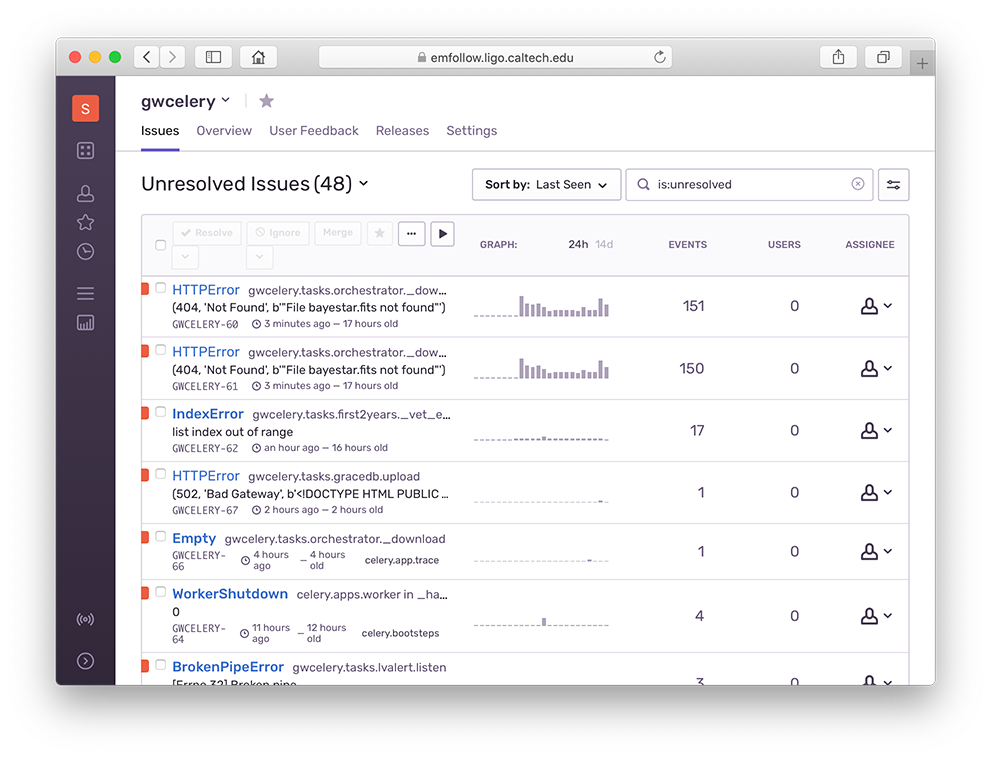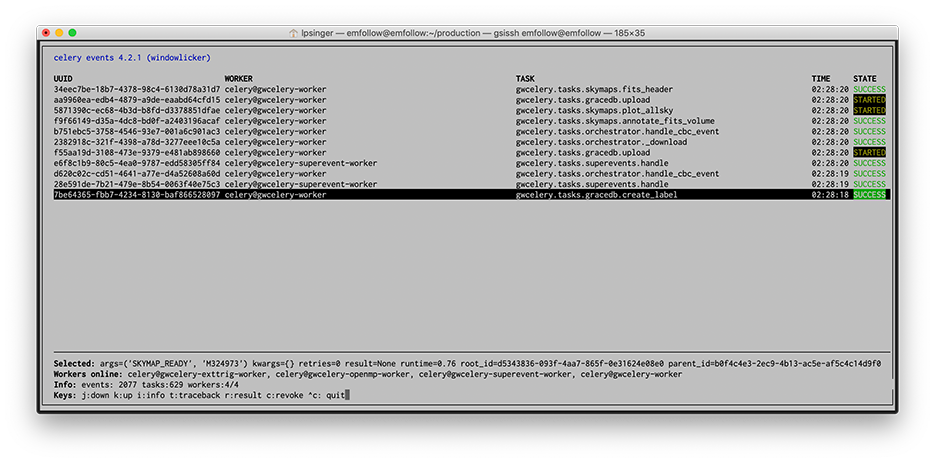Monitoring and Management¶
GWCelery supports a rich selection of management and monitoring tools. Here is an introduction to a few of them. For more Celery monitoring solutions, see the Celery monitoring and management guide.
Flower¶
Flower is a dashboard for monitoring Celery tasks. To start Flower for monitoring during local development, run the following command and then navigate to http://localhost:5555/ in your browser:
$ gwcelery flower
Sentry¶
All warnings, errors, exceptions, and tasks failures are both logged to disk and uploaded instantly to Sentry, an error monitoring and reporting platform. Sentry notifies GWCelery contributors by email when a new bug occurs.
For details about the Sentry logging configuration, see the
gwcelery.sentry module or the Celery integration module in the Sentry
SDK docs.

Flask¶
GWCelery includes a Flask web application that provides forms to manually initiate certain tasks.
To start Flask for monitoring during local development, run the following command and then navigate to http://localhost:5000/ in your browser:
$ gwcelery flask run
Nagios¶
Note
The GWCelery Nagios plugin is tailored to GWCelery and is not sufficiently general to use with other Celery applications.
The dashboard.ligo.org and monitor.ligo.org services use Nagios to monitor and report on the health of all of the components of the low-latency analysis infrastructure.
GWCelery provides the command gwcelery nagios to check the status of the
application and provide a report in the format that Nagios expects.
You can run it manually from the command line:
$ gwcelery nagios
OK: GWCelery is running normally
To configure Nagios itself, see the Nagios configuration overview, or if GWCelery and Nagios are running on different hosts, the Nagios Remote Plugin Executor (NRPE) documentation.
Command-Line Tools¶
All Celery application provide command-line monitoring and management utilities, including the following:
gwcelery shell: Start an interactive Python or IPython interpreter for interacting with Celery. All tasks as well as theappapplication instance are automatically imported and available as globals. Example:$ gwcelery shell Python 3.6.6 (default, Jun 28 2018, 05:43:53) Type 'copyright', 'credits' or 'license' for more information IPython 6.5.0 -- An enhanced Interactive Python. Type '?' for help. In [1]: download.s('coinc.xml', 'M6757').delay().get()
gwcelery call: Call a task from the command line by passing it arguments in JSON format. The output is the unique identifier of the result. Example:$ gwcelery call gwcelery.tasks.gracedb.download --args='["coinc.xml", "M6757"]' d11099e7-75e5-4aa3-800b-b122b667757c
gwcelery result: Get the result of a previously called task. Example:$ gwcelery result ab4aa6d7-9f21-420c-8401-cbe6863cf7dc (b'<?xml version=\'1.0\' encoding=\'utf-8\'?>\n<!DOCTYPE LIGO_LW SYSTEM "htt' b'p://ldas-sw.ligo.caltech.edu/doc/ligolwAPI/html/ligolw_dtd.txt">\n<LIGO_L' ... b'\t</Stream>\n\t</Table>\n</LIGO_LW>\n')
gwcelery events: A text UI monitoring tool that offers functionality similar to Flower. Example:$ gwcelery events
